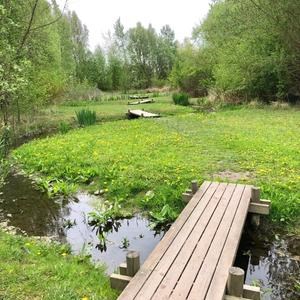From pioneer Landscape Laboratory to a Living Lab Campus
40 years ago, landscape architecture professor Roland Gustavsson, now emeritus, planted small saplings into the windy west flank of Alnarp Campus and developed an experimental wood over the years, an outdoor laboratory termed ‘Landscape Laboratory’ ever since. This pioneer has now sparked the idea of the Living Lab Campus, with room for many more testbeds, trial areas, and experimental landscapes. Alnarp as a Living Lab Campus is a natural progression that builds on the University’s existing strengths while embracing new insights from experimental and transdisciplinary research approaches of the international Living Labs movement.
Alnarp’s Landscape Laboratory as an experimental urban woodland has led to many design and management practice outcomes such as effects of species combination on growth rate, methods for plant field layer establishment, and forest structure prototyping, to name a few. The model expanded to two other complementary landscape labs in Snogeholm in southern Sweden, and Sletten in the city of Holstebro, Denmark. Alnarp is also home to the SLU Garden Laboratory, established in 2002, where research and development experiments are carried out in collaboration with the business sector. Different initiatives across Europe have been pursuing similar living lab experiments that are starting to relate to one another and create a collaborative network.
The time is ripe to formalize the Living Lab Campus with active research projects that both inform and facilitate sustainable landscape development.
The greater pressure on land, water, food systems, and natural resources will call for complementary collaborations to sustain a healthy future.
SLU Living Lab Campus Offers Space and Experience to Embrace Complex Dynamics
SLU’s commitment to sustainability offers the physical space and the experience to extract practice-oriented landscape knowledge, evaluate processes and outcomes, and adapt proven practices to sustainable campus development.
Building on Alnarp’s campus as a model of urban experimentation sites and space for co-learning, and co-production between various disciplines and actors, a new doctorate fellow will conduct a case study to synthesize and deliver knowledge through landscape-oriented physical planning and design and inform the upcoming development of Ultuna campus.
Through fostering collaboration with researchers in design, urban vegetation, and environmental psychology, along with municipal and business actors, the doctorate fellow will explore how campus landscapes can be shaped as educational and research environments that also align as places of encounter for science and society, including areas of high ecological value, public outdoor leisure areas, and places of business for ‘eco-sector’ companies.
A Rich Geographic Context for Transdisciplinary Research
Alnarp’s campus is located between a mix of urban, maritime, and agricultural land. Its proximity to Malmö, Lund, and Copenhagen are also grounds for cultivating transdisciplinary research that brings urban and rural lenses together. This interface is especially important as the global urban population is expected to double within a few decades, and global population is expected to increase to 9 billion by 2050. The International Panel on Climate Change calls out great potential for climate mitigation and adaptation through blue-green infrastructure of these landscapes that need to be put into action. The greater pressure on land, water, food systems, and natural resources will call for complementary collaborations to sustain a healthy future.
For today’s interwoven social, environmental, and economic problems, there is no single creative solution that doesn’t create another problem.
The Need for Living Lab Campus - The Big Picture
SLU as a Living Lab Campus has a clear connection to UN Sustainable Development Goals to meet urgent challenges at the science-society interface and supports capacity building for transformative science to catalyze change. Transformative science is an alternative to earlier modes of knowledge generation. Mode-1 is conventional science motivated by generating knowledge within a specific discipline. Design research generally falls within Mode-2, with a shift to a new transdisciplinary approach with real-world applications. Mode-3 picks up on Mode-2 and adds the transformative component by relating to the dynamic relationship between science and society.
Research has become more specialized and siloed, leading to an immense amount of technological innovation and a rise in efficiency across science, engineering, and design disciplines. There is a downside to these developments. A missing and problematic piece of mode-1 research is reflection and discourse with societal stakeholders regarding positive and negative side effects and risks associated with new technology, products, and practices. For example, scientific innovations that lead to the depletion of natural resources exceeding sustainable regeneration, involve socio-ecological systems that are unaccounted for in Mode-1 research. In a call for embracing transformative science, Schneidewind et al. explain that a reconceptualizing of science is needed to incorporate interdependent socio-ecological transformation processes and the related knowledge to organize societal systems differently.
For today’s interwoven social, environmental, and economic problems, there is no single creative solution that doesn’t create another problem. Transformative science embraces uncertainty and avoids solutionism to work with dynamic situations through a collaborative work process, speculation on new ways of assembling existing material, and adaption of practice experiments to foster co-learning outcomes.
As a civic institution of higher education with a large portfolio of land under its management and a commitment to research and education, SLU is positioned to lead in sustainable development at multiple scales. Building upon this globally rising field of interest and practice, ‘The University Campus as a Living Lab for Sustainability A Practitioner’s Guide and Handbook’, presents the following diagram of 5 scales of influence that higher education institutions have with different complexity and time scales. In short, SLU has impact potential through different actors at each of these geographic scales: classroom, campus, local, regional, and global.






